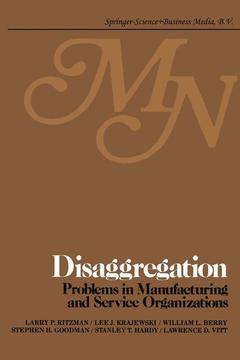Disaggregation, Softcover reprint of the original 1st ed. 1979 Problems in manufacturing and service organizations
Langue : Anglais
Coordonnateurs : Ritzman L.P., Tvrdý M.

This volume is intended to expand the dialogue and interest among both practitioners and academicians in a problem area worthy of attention by all. The concept of disaggregation admits to our current inability to solve many types of interrelated hierarchical problems simultaneously. It offers instead a sequential, iterative process as a workable and necessary procedure. The papers in this volume are selected from those presented at a Disaggregation Conference held in March, 1977 at The Ohio State University. We heartily applaud all those who participated in the conference and particularly appreci ate the cooperation of those authors whose work is published in this collection. Part A contains four papers which define the various dimensions of disaggregation. The paper by Martin Starr, which was the text of his luncheon address at the conference, provides several interesting perspectives to the problem. Although disaggregation suggests tear ing apart, as Professor Starr illustrates with his butterfly example, it also suggests a putting together or a synthesis which recognizes interrelationships and dependencies. The next paper by Lee Kra jewski and Larry Ritzman offers a general model of disaggregation for both the manufacturing and service sectors. After reading the papers in this section, as well as the papers in subsequent sections, you will identify other dimensions to hierarchical decision making which go beyond this generalized model.
1. Perspectives on disaggregation.- 2. Disaggregation in manufacturing and service organizations: survey of problems and research.- 3. Toward a theory of hierarchical coordination and conflict.- 4. An MSA view of disaggregation.- 5. Hierarchical planning systems: a production application.- 6. Optimal aggregation and disaggregation in hierarchical planning.- 7. A hierarchical approach for the planning of a complex production system.- 8. A hierarchical approach to multilocation inventory systems.- 9. A disaggregation problem and a search enumeration algorithm for a multiplant, multiproduct scheduling application.- 10. An efficient algorithm for multi-item scheduling.- 11. Large scale optimization for master production scheduling.- 12. Multi-item scheduling with reflection programming.- 13. An approach to the analysis of integrated production-distribution systems.- 14. Empirical relationships among budgets, other financially-oriented aggregate plans, and the master production schedule (MPS).- 15. Hedging the master schedule.- 16. The disaggregation problem in the paper industry.- 17. An economic lot size algorithm for multi-level inventory systems with acyclic network structures.- 18. Impact of a product structure measure on the effectiveness of lot sizing techniques.- 19. The effects of joint lot size strategies on capacity related performance in a multi-stage production-inventory system.- 20. The impact of capacity on lot sizing decisions.- 21. Variations in optimizing serial multi-stage production/inventory systems.- 22. Priority updating procedures in dynamic job shop simulation studies: the impact on measures of performance under different due date assignment rules.- 23. A review of flowshop scheduling research.- 24. An aggregate-disaggregate approach to the large scale multiple project scheduling problem.- 25. Shift scheduling for telephone operators and service office employees.- 26. A complete control system for workforce management at a post office.- 27. Decision making in the public sector: an application of goal interval programming for disaggregation in the post office.- 28. Disaggregation of manpower in a service organization.- 29. Facilities planning in the railroad industry: the need for disaggregation.- 30. Vehicle dispatching — sweep algorithm and extensions.- 31. Navy enlisted manpower planning.- 32. A public policy optimization model with simulation of disaggregation aspects: formulation of energy R and D policy.- 33. Costs and benefits of a computer based regional blood inventory system.- 34. Multi-level police patrol planning.- 35. Disaggregation of the decisions to allocate patrol resources to police precincts.- 36. Economically optimal quantity and mix of fire department services.- 37. Disaggregation planning, scheduling and allocation of nursing staff.- 38. ‘Disaggregate mathematical models of optimal hospital bed management.- 39. Recursive modeling of outpatient health care settings.- 40. Nurse scheduling: a case of disaggregation in the public sector.- 41. Computerized scheduling of hospital nursing personnel: disaggregation to accommodate individual preferences and nonroutine constraints.- 42. Disaggregating health utilization data for planning.- 43. Scheduling workers in situations having highly variable manpower requirements.- 44. Optimal scheduling of two consecutive work periods.- 45. A simple method for obtaining cyclic employee schedules.- 46. Heuristic work force scheduling with variable shift lengths and labor productivity differences: a case study of encoder staffing.
Date de parution : 12-2012
Ouvrage de 703 p.
15.2x22.9 cm
Disponible chez l'éditeur (délai d'approvisionnement : 15 jours).
Prix indicatif 105,49 €
Ajouter au panierThème de Disaggregation :
Mots-clés :
Manufacturing; algorithms; decision making; modeling; optimization; production; productivity; public policy; scheduling; simulation
© 2024 LAVOISIER S.A.S.
